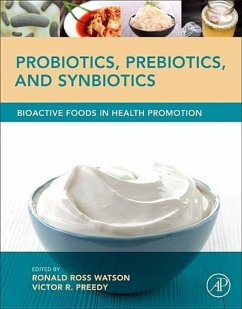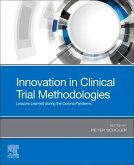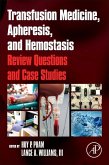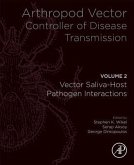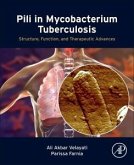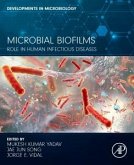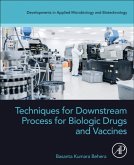Probiotics, Prebiotics, and Synbiotics
Bioactive Foods in Health Promotion
Herausgeber: Watson, Ronald Ross; Preedy, Victor R
Probiotics, Prebiotics, and Synbiotics
Bioactive Foods in Health Promotion
Herausgeber: Watson, Ronald Ross; Preedy, Victor R
- Gebundenes Buch
- Merkliste
- Auf die Merkliste
- Bewerten Bewerten
- Teilen
- Produkt teilen
- Produkterinnerung
- Produkterinnerung
Probiotics, Prebiotics, and Synbiotics: Bioactive Foods in Health Promotion reviews and presents new hypotheses and conclusions on the effects of different bioactive components of probiotics, prebiotics, and synbiotics to prevent disease and improve the health of various populations. Experts define and support the actions of bacteria; bacteria modified bioflavonoids and prebiotic fibrous materials and vegetable compounds. A major emphasis is placed on the health-promoting activities and bioactive components of probiotic bacteria.
Andere Kunden interessierten sich auch für
![Innovation in Clinical Trial Methodologies Innovation in Clinical Trial Methodologies]() Innovation in Clinical Trial Methodologies107,99 €
Innovation in Clinical Trial Methodologies107,99 €![Transfusion Medicine, Apheresis, and Hemostasis Transfusion Medicine, Apheresis, and Hemostasis]() Huy P. PhamTransfusion Medicine, Apheresis, and Hemostasis106,99 €
Huy P. PhamTransfusion Medicine, Apheresis, and Hemostasis106,99 €![Arthropod Vector: Controller of Disease Transmission, Volume 2 Arthropod Vector: Controller of Disease Transmission, Volume 2]() Arthropod Vector: Controller of Disease Transmission, Volume 2105,99 €
Arthropod Vector: Controller of Disease Transmission, Volume 2105,99 €![Pili in Mycobacterium Tuberculosis Pili in Mycobacterium Tuberculosis]() Ali Akbar Velayati (Mycobacteriology Research Center (MRC) and DirePili in Mycobacterium Tuberculosis184,99 €
Ali Akbar Velayati (Mycobacteriology Research Center (MRC) and DirePili in Mycobacterium Tuberculosis184,99 €![Microbial Biofilms Microbial Biofilms]() Microbial Biofilms183,99 €
Microbial Biofilms183,99 €![The Potential of Microbes for a Circular Economy The Potential of Microbes for a Circular Economy]() The Potential of Microbes for a Circular Economy183,99 €
The Potential of Microbes for a Circular Economy183,99 €![Techniques for Downstream Process for Biologic Drugs and Vaccines Techniques for Downstream Process for Biologic Drugs and Vaccines]() Basanta Kumara Behera (Advanced Center for Biotech Former DirectorTechniques for Downstream Process for Biologic Drugs and Vaccines184,99 €
Basanta Kumara Behera (Advanced Center for Biotech Former DirectorTechniques for Downstream Process for Biologic Drugs and Vaccines184,99 €-
-
-
Probiotics, Prebiotics, and Synbiotics: Bioactive Foods in Health Promotion reviews and presents new hypotheses and conclusions on the effects of different bioactive components of probiotics, prebiotics, and synbiotics to prevent disease and improve the health of various populations. Experts define and support the actions of bacteria; bacteria modified bioflavonoids and prebiotic fibrous materials and vegetable compounds. A major emphasis is placed on the health-promoting activities and bioactive components of probiotic bacteria.
Hinweis: Dieser Artikel kann nur an eine deutsche Lieferadresse ausgeliefert werden.
Hinweis: Dieser Artikel kann nur an eine deutsche Lieferadresse ausgeliefert werden.
Produktdetails
- Produktdetails
- Verlag: Elsevier Science Publishing Co Inc
- Seitenzahl: 938
- Erscheinungstermin: 8. Oktober 2015
- Englisch
- Abmessung: 284mm x 220mm x 53mm
- Gewicht: 2832g
- ISBN-13: 9780128021897
- ISBN-10: 0128021896
- Artikelnr.: 43057409
- Herstellerkennzeichnung
- Libri GmbH
- Europaallee 1
- 36244 Bad Hersfeld
- gpsr@libri.de
- Verlag: Elsevier Science Publishing Co Inc
- Seitenzahl: 938
- Erscheinungstermin: 8. Oktober 2015
- Englisch
- Abmessung: 284mm x 220mm x 53mm
- Gewicht: 2832g
- ISBN-13: 9780128021897
- ISBN-10: 0128021896
- Artikelnr.: 43057409
- Herstellerkennzeichnung
- Libri GmbH
- Europaallee 1
- 36244 Bad Hersfeld
- gpsr@libri.de
Part 1: Prebiotics in Health Promotion
1. Prebiotics and probiotics: An assessment of their safety and health
benefits
2. Pre- and Probiotic Supplementation in Ruminant Livestock Production
3. Prebiotic addition in dairy products: processing and health benefits
4. Low lactose Prebiotic-enriched milk
5. Intestinal microbiota in breast-fed infants: insights into
infant-associated bifidobacteria and human milk glycans
6. Probiotics and Prebiotics for Promoting Health: via Gut Microbiota
7. Prebiotics in human milk and in infant formulas
8. Prebiotics and Probiotics in infant nutrition
9. Synthesis of Prebiotic Galactooligosaccharides: Science and Technology
10. Prebiotics as protectants of lactic acid bacteria
11. Prebiotic agave fructans and immune aspects
12. Prebiotic use in children
13. Structural characteristics and prebiotic effects of lotus seed
resistant starch
Part 2: Probiotics in Food
14. Probiotic Lactobacillus strains from Iranian traditional cheeses
15. Safety of Probiotic Bacteria
16. Stressors and food environment: towards strategies to improve
robustness and stress tolerance in probiotic
17. Effect of food composition on probiotic bacteria viability
18. Probiotics and antibiotic use
19. Multistrain Probiotics: the present forward the future
20. Production of Probiotic Cultures and Their Incorporation into Foods
21. Prebiotics and Other Microbial Manipulations in Fish Feeds: Prospective
Update of Health benefits
22. Current and future applications of bacterial extracellular
polysaccharides
23. Probiotic and prebiotic dairy desserts
24. Lactobacillus paracasei-enriched vegetables containing health promoting
molecules
25. Probiotics from the olive microbiota
26. Kimchi (Korean fermented vegetables) as a probiotic food
27. Probiotics as potential adsorbent of aflatoxin
Part 3: Synbiotics: Production, Application, and Health Promotion
28. Beta-glucans and synbiotics
29. Probiotics and synbiotics in lactating mothers
30. Symbiotics and the immune system
31. Synbiotics and immunization against H9N2 Avian influenza virus
32. Probiotics, prebiotics, synbiotics and foodborne illness
33. In vitro screening and evaluation of synbiotics
34. Synbiotics and infantile acute gastroenteritis
35. Symbiotics, probiotics and fiber diet in diverticular disease
36. Gut Microbiota: Impact of Probiotics, Prebiotics, Synbiotics,
Pharmabiotics and Postbiotics on Human Health
37. Potential benefits of probiotics, prebiotics, and synbiotic on the
intestinal microbiota of the elderly
38. Synbiotics in gastrointestinal surgery
39. Probiotics, Prebiotics, Synbiotics and other strategies to modulate the
gut microbiota in Irritable Bowel Syndrome (IBS)
40. Gut microbiota & IBS
41. Synbiotics: a new strategy to improve immune system from gut to the
peripheral sites
42. Probiotics and prebiotics for prevention of viral respiratory tract
infections
43. Synbiotics in the Intensive Care Unit
44. Properties of probiotic bacteria: a proteomic approach
45. Symbiotic organisms and gut epithelial homeostasis
46. Non prebiotic actions of prebiotics
Part 4: Probiotics in Health
47. Probiotics and physical strength
48. Probiotics in Invasive Candidiasis
49. Probiotics and usage in bacterial vaginosis
50. Evidence and rational for probiotics to prevent infections in the
elderly
51. Probiotics usage in childhood Helicobacter pylori infection
52. Lipoic acid function and its safety in Multiple sclerosis
53. Probiotics and health: What publication rate on probiotics, prebiotics
and synbiotics implies?
54. The Cholesterol lowering effects of probiotic bacteria on lipid
metabolism
55. The Use of Prebiotics, Probiotics, and Synbiotics in the Critically Ill
56. Gynecological health and probiotics
Part 5: Probiotics and Chronic Diseases
57. Probiotics in inflamatory bowel diseases and cancer prevention
58. Resistant starch as a bioactive compound in Colorectal Cancer
prevention
59. Probiotics in cancer prevention, updating the evidence
60. Cardiovascular Health and Disease Prevention: Association with
Foodborne Pathogens and Potential Benefits of
Probiotics
61. Probiotics usage in heart disease and psychiatry
62. Intestinal microbiota and susceptibility to viral infections. Role of
probiotics.
63. Probiotics and usage in urinary tract infection
64. Probiotics: immunomodulatory properties in allergy and eczema
65. Prebiotics and Probiotics for the Prevention and Treatment of Food
Allergy
66. Prebiotics and probiotics for the prevention and treatment of allergic
asthma
67. Amelioration of Helicobacter pylori induced PUD by probiotic lactic
acid bacteria
1. Prebiotics and probiotics: An assessment of their safety and health
benefits
2. Pre- and Probiotic Supplementation in Ruminant Livestock Production
3. Prebiotic addition in dairy products: processing and health benefits
4. Low lactose Prebiotic-enriched milk
5. Intestinal microbiota in breast-fed infants: insights into
infant-associated bifidobacteria and human milk glycans
6. Probiotics and Prebiotics for Promoting Health: via Gut Microbiota
7. Prebiotics in human milk and in infant formulas
8. Prebiotics and Probiotics in infant nutrition
9. Synthesis of Prebiotic Galactooligosaccharides: Science and Technology
10. Prebiotics as protectants of lactic acid bacteria
11. Prebiotic agave fructans and immune aspects
12. Prebiotic use in children
13. Structural characteristics and prebiotic effects of lotus seed
resistant starch
Part 2: Probiotics in Food
14. Probiotic Lactobacillus strains from Iranian traditional cheeses
15. Safety of Probiotic Bacteria
16. Stressors and food environment: towards strategies to improve
robustness and stress tolerance in probiotic
17. Effect of food composition on probiotic bacteria viability
18. Probiotics and antibiotic use
19. Multistrain Probiotics: the present forward the future
20. Production of Probiotic Cultures and Their Incorporation into Foods
21. Prebiotics and Other Microbial Manipulations in Fish Feeds: Prospective
Update of Health benefits
22. Current and future applications of bacterial extracellular
polysaccharides
23. Probiotic and prebiotic dairy desserts
24. Lactobacillus paracasei-enriched vegetables containing health promoting
molecules
25. Probiotics from the olive microbiota
26. Kimchi (Korean fermented vegetables) as a probiotic food
27. Probiotics as potential adsorbent of aflatoxin
Part 3: Synbiotics: Production, Application, and Health Promotion
28. Beta-glucans and synbiotics
29. Probiotics and synbiotics in lactating mothers
30. Symbiotics and the immune system
31. Synbiotics and immunization against H9N2 Avian influenza virus
32. Probiotics, prebiotics, synbiotics and foodborne illness
33. In vitro screening and evaluation of synbiotics
34. Synbiotics and infantile acute gastroenteritis
35. Symbiotics, probiotics and fiber diet in diverticular disease
36. Gut Microbiota: Impact of Probiotics, Prebiotics, Synbiotics,
Pharmabiotics and Postbiotics on Human Health
37. Potential benefits of probiotics, prebiotics, and synbiotic on the
intestinal microbiota of the elderly
38. Synbiotics in gastrointestinal surgery
39. Probiotics, Prebiotics, Synbiotics and other strategies to modulate the
gut microbiota in Irritable Bowel Syndrome (IBS)
40. Gut microbiota & IBS
41. Synbiotics: a new strategy to improve immune system from gut to the
peripheral sites
42. Probiotics and prebiotics for prevention of viral respiratory tract
infections
43. Synbiotics in the Intensive Care Unit
44. Properties of probiotic bacteria: a proteomic approach
45. Symbiotic organisms and gut epithelial homeostasis
46. Non prebiotic actions of prebiotics
Part 4: Probiotics in Health
47. Probiotics and physical strength
48. Probiotics in Invasive Candidiasis
49. Probiotics and usage in bacterial vaginosis
50. Evidence and rational for probiotics to prevent infections in the
elderly
51. Probiotics usage in childhood Helicobacter pylori infection
52. Lipoic acid function and its safety in Multiple sclerosis
53. Probiotics and health: What publication rate on probiotics, prebiotics
and synbiotics implies?
54. The Cholesterol lowering effects of probiotic bacteria on lipid
metabolism
55. The Use of Prebiotics, Probiotics, and Synbiotics in the Critically Ill
56. Gynecological health and probiotics
Part 5: Probiotics and Chronic Diseases
57. Probiotics in inflamatory bowel diseases and cancer prevention
58. Resistant starch as a bioactive compound in Colorectal Cancer
prevention
59. Probiotics in cancer prevention, updating the evidence
60. Cardiovascular Health and Disease Prevention: Association with
Foodborne Pathogens and Potential Benefits of
Probiotics
61. Probiotics usage in heart disease and psychiatry
62. Intestinal microbiota and susceptibility to viral infections. Role of
probiotics.
63. Probiotics and usage in urinary tract infection
64. Probiotics: immunomodulatory properties in allergy and eczema
65. Prebiotics and Probiotics for the Prevention and Treatment of Food
Allergy
66. Prebiotics and probiotics for the prevention and treatment of allergic
asthma
67. Amelioration of Helicobacter pylori induced PUD by probiotic lactic
acid bacteria
Part 1: Prebiotics in Health Promotion
1. Prebiotics and probiotics: An assessment of their safety and health
benefits
2. Pre- and Probiotic Supplementation in Ruminant Livestock Production
3. Prebiotic addition in dairy products: processing and health benefits
4. Low lactose Prebiotic-enriched milk
5. Intestinal microbiota in breast-fed infants: insights into
infant-associated bifidobacteria and human milk glycans
6. Probiotics and Prebiotics for Promoting Health: via Gut Microbiota
7. Prebiotics in human milk and in infant formulas
8. Prebiotics and Probiotics in infant nutrition
9. Synthesis of Prebiotic Galactooligosaccharides: Science and Technology
10. Prebiotics as protectants of lactic acid bacteria
11. Prebiotic agave fructans and immune aspects
12. Prebiotic use in children
13. Structural characteristics and prebiotic effects of lotus seed
resistant starch
Part 2: Probiotics in Food
14. Probiotic Lactobacillus strains from Iranian traditional cheeses
15. Safety of Probiotic Bacteria
16. Stressors and food environment: towards strategies to improve
robustness and stress tolerance in probiotic
17. Effect of food composition on probiotic bacteria viability
18. Probiotics and antibiotic use
19. Multistrain Probiotics: the present forward the future
20. Production of Probiotic Cultures and Their Incorporation into Foods
21. Prebiotics and Other Microbial Manipulations in Fish Feeds: Prospective
Update of Health benefits
22. Current and future applications of bacterial extracellular
polysaccharides
23. Probiotic and prebiotic dairy desserts
24. Lactobacillus paracasei-enriched vegetables containing health promoting
molecules
25. Probiotics from the olive microbiota
26. Kimchi (Korean fermented vegetables) as a probiotic food
27. Probiotics as potential adsorbent of aflatoxin
Part 3: Synbiotics: Production, Application, and Health Promotion
28. Beta-glucans and synbiotics
29. Probiotics and synbiotics in lactating mothers
30. Symbiotics and the immune system
31. Synbiotics and immunization against H9N2 Avian influenza virus
32. Probiotics, prebiotics, synbiotics and foodborne illness
33. In vitro screening and evaluation of synbiotics
34. Synbiotics and infantile acute gastroenteritis
35. Symbiotics, probiotics and fiber diet in diverticular disease
36. Gut Microbiota: Impact of Probiotics, Prebiotics, Synbiotics,
Pharmabiotics and Postbiotics on Human Health
37. Potential benefits of probiotics, prebiotics, and synbiotic on the
intestinal microbiota of the elderly
38. Synbiotics in gastrointestinal surgery
39. Probiotics, Prebiotics, Synbiotics and other strategies to modulate the
gut microbiota in Irritable Bowel Syndrome (IBS)
40. Gut microbiota & IBS
41. Synbiotics: a new strategy to improve immune system from gut to the
peripheral sites
42. Probiotics and prebiotics for prevention of viral respiratory tract
infections
43. Synbiotics in the Intensive Care Unit
44. Properties of probiotic bacteria: a proteomic approach
45. Symbiotic organisms and gut epithelial homeostasis
46. Non prebiotic actions of prebiotics
Part 4: Probiotics in Health
47. Probiotics and physical strength
48. Probiotics in Invasive Candidiasis
49. Probiotics and usage in bacterial vaginosis
50. Evidence and rational for probiotics to prevent infections in the
elderly
51. Probiotics usage in childhood Helicobacter pylori infection
52. Lipoic acid function and its safety in Multiple sclerosis
53. Probiotics and health: What publication rate on probiotics, prebiotics
and synbiotics implies?
54. The Cholesterol lowering effects of probiotic bacteria on lipid
metabolism
55. The Use of Prebiotics, Probiotics, and Synbiotics in the Critically Ill
56. Gynecological health and probiotics
Part 5: Probiotics and Chronic Diseases
57. Probiotics in inflamatory bowel diseases and cancer prevention
58. Resistant starch as a bioactive compound in Colorectal Cancer
prevention
59. Probiotics in cancer prevention, updating the evidence
60. Cardiovascular Health and Disease Prevention: Association with
Foodborne Pathogens and Potential Benefits of
Probiotics
61. Probiotics usage in heart disease and psychiatry
62. Intestinal microbiota and susceptibility to viral infections. Role of
probiotics.
63. Probiotics and usage in urinary tract infection
64. Probiotics: immunomodulatory properties in allergy and eczema
65. Prebiotics and Probiotics for the Prevention and Treatment of Food
Allergy
66. Prebiotics and probiotics for the prevention and treatment of allergic
asthma
67. Amelioration of Helicobacter pylori induced PUD by probiotic lactic
acid bacteria
1. Prebiotics and probiotics: An assessment of their safety and health
benefits
2. Pre- and Probiotic Supplementation in Ruminant Livestock Production
3. Prebiotic addition in dairy products: processing and health benefits
4. Low lactose Prebiotic-enriched milk
5. Intestinal microbiota in breast-fed infants: insights into
infant-associated bifidobacteria and human milk glycans
6. Probiotics and Prebiotics for Promoting Health: via Gut Microbiota
7. Prebiotics in human milk and in infant formulas
8. Prebiotics and Probiotics in infant nutrition
9. Synthesis of Prebiotic Galactooligosaccharides: Science and Technology
10. Prebiotics as protectants of lactic acid bacteria
11. Prebiotic agave fructans and immune aspects
12. Prebiotic use in children
13. Structural characteristics and prebiotic effects of lotus seed
resistant starch
Part 2: Probiotics in Food
14. Probiotic Lactobacillus strains from Iranian traditional cheeses
15. Safety of Probiotic Bacteria
16. Stressors and food environment: towards strategies to improve
robustness and stress tolerance in probiotic
17. Effect of food composition on probiotic bacteria viability
18. Probiotics and antibiotic use
19. Multistrain Probiotics: the present forward the future
20. Production of Probiotic Cultures and Their Incorporation into Foods
21. Prebiotics and Other Microbial Manipulations in Fish Feeds: Prospective
Update of Health benefits
22. Current and future applications of bacterial extracellular
polysaccharides
23. Probiotic and prebiotic dairy desserts
24. Lactobacillus paracasei-enriched vegetables containing health promoting
molecules
25. Probiotics from the olive microbiota
26. Kimchi (Korean fermented vegetables) as a probiotic food
27. Probiotics as potential adsorbent of aflatoxin
Part 3: Synbiotics: Production, Application, and Health Promotion
28. Beta-glucans and synbiotics
29. Probiotics and synbiotics in lactating mothers
30. Symbiotics and the immune system
31. Synbiotics and immunization against H9N2 Avian influenza virus
32. Probiotics, prebiotics, synbiotics and foodborne illness
33. In vitro screening and evaluation of synbiotics
34. Synbiotics and infantile acute gastroenteritis
35. Symbiotics, probiotics and fiber diet in diverticular disease
36. Gut Microbiota: Impact of Probiotics, Prebiotics, Synbiotics,
Pharmabiotics and Postbiotics on Human Health
37. Potential benefits of probiotics, prebiotics, and synbiotic on the
intestinal microbiota of the elderly
38. Synbiotics in gastrointestinal surgery
39. Probiotics, Prebiotics, Synbiotics and other strategies to modulate the
gut microbiota in Irritable Bowel Syndrome (IBS)
40. Gut microbiota & IBS
41. Synbiotics: a new strategy to improve immune system from gut to the
peripheral sites
42. Probiotics and prebiotics for prevention of viral respiratory tract
infections
43. Synbiotics in the Intensive Care Unit
44. Properties of probiotic bacteria: a proteomic approach
45. Symbiotic organisms and gut epithelial homeostasis
46. Non prebiotic actions of prebiotics
Part 4: Probiotics in Health
47. Probiotics and physical strength
48. Probiotics in Invasive Candidiasis
49. Probiotics and usage in bacterial vaginosis
50. Evidence and rational for probiotics to prevent infections in the
elderly
51. Probiotics usage in childhood Helicobacter pylori infection
52. Lipoic acid function and its safety in Multiple sclerosis
53. Probiotics and health: What publication rate on probiotics, prebiotics
and synbiotics implies?
54. The Cholesterol lowering effects of probiotic bacteria on lipid
metabolism
55. The Use of Prebiotics, Probiotics, and Synbiotics in the Critically Ill
56. Gynecological health and probiotics
Part 5: Probiotics and Chronic Diseases
57. Probiotics in inflamatory bowel diseases and cancer prevention
58. Resistant starch as a bioactive compound in Colorectal Cancer
prevention
59. Probiotics in cancer prevention, updating the evidence
60. Cardiovascular Health and Disease Prevention: Association with
Foodborne Pathogens and Potential Benefits of
Probiotics
61. Probiotics usage in heart disease and psychiatry
62. Intestinal microbiota and susceptibility to viral infections. Role of
probiotics.
63. Probiotics and usage in urinary tract infection
64. Probiotics: immunomodulatory properties in allergy and eczema
65. Prebiotics and Probiotics for the Prevention and Treatment of Food
Allergy
66. Prebiotics and probiotics for the prevention and treatment of allergic
asthma
67. Amelioration of Helicobacter pylori induced PUD by probiotic lactic
acid bacteria

